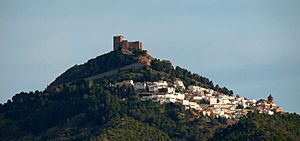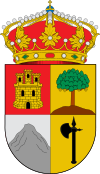Segura de la Sierra facts for kids
Quick facts for kids
Segura de la Sierra
|
||
|---|---|---|

The Town and its castle
|
||
|
||
| Country | ||
| Autonomous community | ||
| Province | Jaén | |
| Comarca | Sierra de Segura | |
| Area | ||
| • Total | 224 km2 (86 sq mi) | |
| Elevation | 1,145 m (3,757 ft) | |
| Population
(2018)
|
||
| • Total | 1,782 | |
| • Density | 7.955/km2 (20.60/sq mi) | |
| Demonym(s) | Segureño, ña | |
| Time zone | UTC+1 (CET) | |
| • Summer (DST) | UTC+2 (CEST) | |
| Postal code |
23379
|
|
| Dialing code | (+34) 953 48 XX XX | |
| Official language(s) | Spanish | |
Segura de la Sierra is a small village located in the Jaén province of Spain. It is part of the Sierra de Segura region in eastern Andalusia.
In 2005, about 1,771 people lived in the town. All of them lived within the Sierras de Cazorla, Segura y Las Villas Natural Park. This park includes several smaller villages:
- Cortijos Nuevos
- El Ojuelo
- Carrasco
- La Alberquilla
- El Robledo
- Rihornos
- Trujala
- Arroyo frío
- Río Madera and Arroyo Canales
- Catena
- El Tobazo
- El Puerto
Contents
A Look at Segura de la Sierra's Past
The most important time for Segura de la Sierra was during the Arab rule. Back then, the town was known as Saqura. In 781 AD, a leader named Abul-Asvar took control of the village. He was responsible for building the strong walls that still surround the town today. The people were governed by walíes, who were like local rulers serving the kings of Córdoba.
Changes in Control: From Arabs to Christians
After some battles between the Almohads (a group from North Africa) and the Christians, the Christians took over. King Alfonso VIII then gave the village to the military Order of Santiago. Many important nobles and famous people, including the poet Jorge Manrique, were born or lived here during that time.
When Castilian troops took control, some of the people from Segura de la Sierra moved to the city of Safi in Morocco. To this day, their descendants are known by the last name Shequri.
The Impact of Napoleon's Invasion
During the invasion by Napoleon's troops, the town was set on fire. Sadly, most of its historical records and documents were destroyed. This meant that a large part of the village's history was lost forever.
Exploring Segura de la Sierra's Monuments
In 1972, Segura de la Sierra was named a Conjunto Histórico-Artístico. This means it is recognized as a historic and artistic site. The village still looks much like it did in the past, with its quiet and beautiful streets.
The Famous Mudéjar Castle
The most important building is the Mudéjar Castle. It sits high up on top of the town, surrounded by the old walls. This castle is a great example of Mudéjar architecture, which mixes Christian and Islamic styles.
Other Important Buildings and Art
Near the castle, you can find the Fountain of Carlos V. It is decorated with his royal shield. Close by is the Church of Nuestra Señora del Collado. Inside, it has a beautiful painting called the "Descendimiento" by Gregorio Hernández. There is also a Romanic sculpture of the Virgen de la Peña.
The old School of the Jesuitas, with its fancy plateresca style front, has been restored. It now serves as the town's Council building.
Finally, the Arabian baths, which are from the 11th century, have also been restored. Visitors can now explore these ancient baths.
Local Celebrations and Fun
The biggest local celebration in Segura de la Sierra is the festival of the Virgen del Rosario. It takes place between October 4th and 8th. This event combines religious traditions with cultural activities. During these days, many people from nearby villages come to join the fun.
Festivities and Games
During the day, people enjoy bullfighting in the Arabian square, which is located below the Castle. There is also a competition of Bolos serranos, a traditional bowling game. The evenings are filled with music and dancing, often featuring traditional pasodoble dances.
See also
 In Spanish: Segura de la Sierra para niños
In Spanish: Segura de la Sierra para niños





